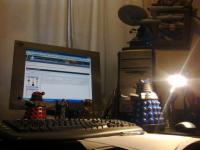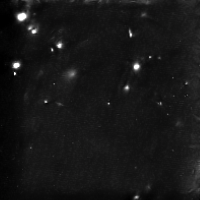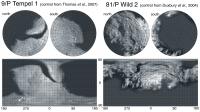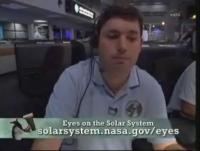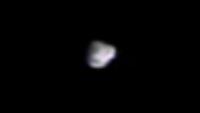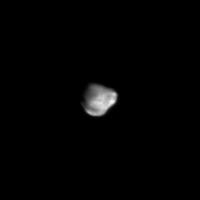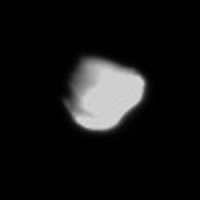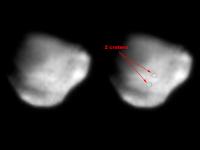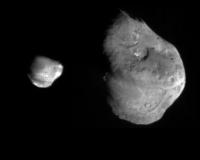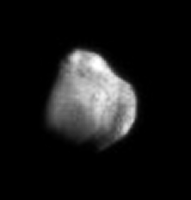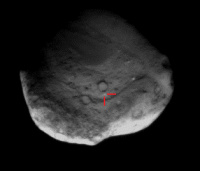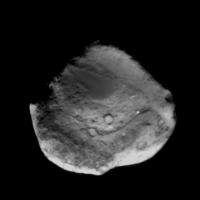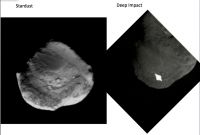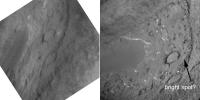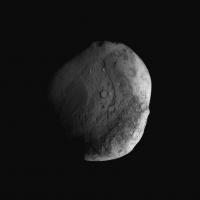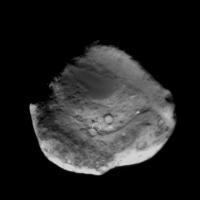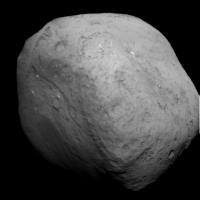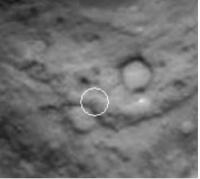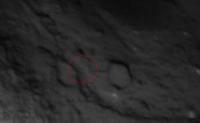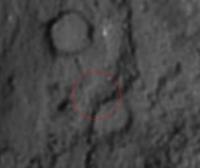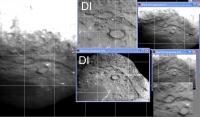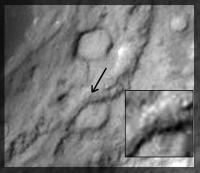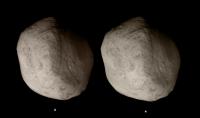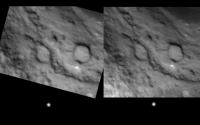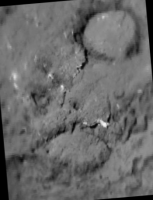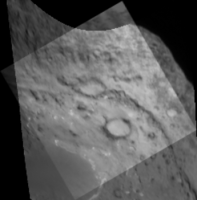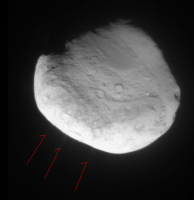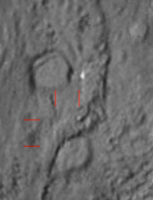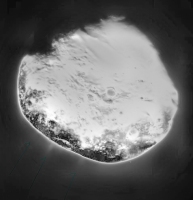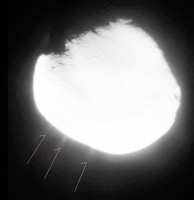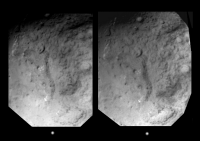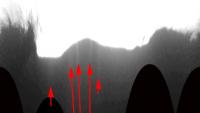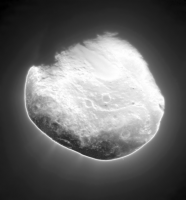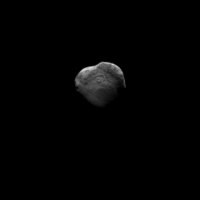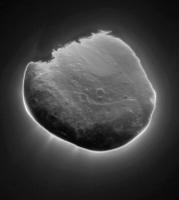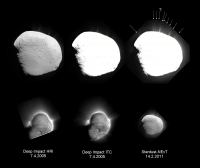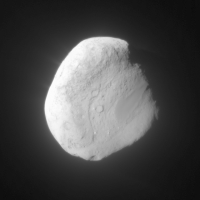Printable Version of Topic
Click here to view this topic in its original format
Unmanned Spaceflight.com _ Cometary and Asteroid Missions _ Stardust-NExT
Posted by: Paolo Dec 28 2010, 01:46 PM
I thought it was time to start a new thread on Stardust's flyby of Tempel 1, the first time a comet receives a second visit from a spacecraft one perihelion later.
There was an interesting story about this on Spaceflight now recently http://www.spaceflightnow.com/news/n1012/23stardustnext/
note that the flyby will be around 23.30 eastern time on 14 February, so thinking in GMT it will not happen on Valentine's day.
Stardust should have started imaging Tempel 1 twice weekly in mid-December, but there is nothing yet on the mission site http://stardustnext.jpl.nasa.gov/index.html
see also http://stardustnext.jpl.nasa.gov/mission/mission_status10_q4.html for updates on the mission status
Posted by: ElkGroveDan Dec 28 2010, 01:56 PM
Ladies and gentleman we have a new never-seen-before unit of measure of volume, the "office desk."
Posted by: Stu Dec 28 2010, 02:52 PM
Hmmm. Now, is that an office desk in its naked, uncluttered state, or one that's covered in post-Christmas stuff? 'Cos if they're going to base their measurements on mine then that's going to seriously mess up any calculations, you know..?
Posted by: djellison Dec 28 2010, 04:09 PM
It's not that small really - http://stardustnext.jpl.nasa.gov/multimedia/sc.html - if my desk was that big, I wouldn't fit in my cube anymore ![]()
I'm changing the thread title to be more appropriate.
Posted by: centsworth_II Dec 28 2010, 05:24 PM
We've come a long way since the early days when only a breadbox was available as a unit of measure!
Posted by: ZLD Dec 28 2010, 05:34 PM
Right, it's more the size of an outhouse. That doesn't seem an appropriate unit of size either though...
I'm really glad they are able to start doing more intricate extended missions like this and Deep Impact. 2011 appears to possibly be the most productuctive year for astronomy in some time. Should be quite exciting.
Posted by: elakdawalla Dec 29 2010, 06:16 PM
I think that the Web outreach for this encounter is going to be less than the mission would like it to be because of unavoidable timing problems. It's a small team and everybody who's involved in Stardust was also involved in Deep Impact/Hartley 2 -- same science team, same outreach folks. They were spread too thin to do much advance work on Stardust -- and then there were the holidays. I know they are scrambling now to get their website prepared for the flyby but I don't think we can expect a whole lot of advance information.
Posted by: JohnVV Dec 29 2010, 11:56 PM
that is because the clutter was " EXTERMINATE , EXTERRRRAAAMINATEEE... "
the "desk" ????
well is it bigger than " fill in ...the blank "
some of the young folk here might have never seen a bread box
nor have had the "bread person" deliver house to house
orieies bakery ( i think it's name was ) delivered when i was a young kid
Posted by: ups Dec 30 2010, 12:00 AM
I hope this thing is bigger than my office desk or we aren't going to get much science back.
![]()
Posted by: djellison Dec 30 2010, 12:41 AM
The spacecraft bus is basically 6ft x 2ft x 2ft - and the high gain antena is just short of 2ft across. This is a small, light (<400kg all up), cheap spacecraft.... but it's still not a desk ![]()
Posted by: nprev Dec 30 2010, 12:50 AM
Surely some imagemage will shortly produce a faux movie poster for "Attack Of The Spacedesks"...but not post it on this thread! ![]()
Posted by: elakdawalla Dec 30 2010, 01:13 AM
In the hopes of dragging this thread back to some actual discussion of the Stardust mission, I thought I'd post this somewhat worrying http://stardustnext.jpl.nasa.gov/mission/mission_status10_q4.html:
Posted by: tedstryk Dec 30 2010, 01:24 AM
Ugh.
Posted by: nprev Dec 30 2010, 01:32 AM
On the plus side this sounds like a well-understood fault state (esp. because it appears that there is some heritage with this system), and they are taking preventative actions well before the flyby.
Just gotta keep her together for another 3 months or so...go Stardust-NExT!
Posted by: volcanopele Dec 30 2010, 02:58 AM
Quick question: is the rotation of Temple 1 understood well enough that the mission planner's can ensure that the DI impact site will be on the comet's sunlit side when Stardust-NExT flies by?
Posted by: Decepticon Dec 30 2010, 03:04 AM
According to this yes. http://www.sdnext.org/mission/pdfs/SD_NEXT_Fctsht.pdf
Posted by: stevesliva Dec 30 2010, 03:30 AM
Yeah, just a bit flip. Somewhat amusing that it was an error with the error-checking, if I read that right.
Posted by: djellison Dec 30 2010, 03:46 AM
Actually - I would urge caution on the crater observation. It's a goal, but it's not a certainty. The mag-curve of the nucleus is double bumped, and using the shape model you can match it very well in both bumps - so basically, we may get the crater, or we may not.
If we get it - awesome. If we don't - we get to map the other side of the Nucleus which is also awesome.
Posted by: JohnVV Dec 30 2010, 05:35 AM
?? i would not use "somewhat worrying" it looks like a normal everyday address allocation bug
At least it is not a BSOD
sounds like a raid 1 set up
Posted by: stevesliva Dec 30 2010, 05:50 AM
Yeah, pretty much. Sounds like they're comparing addresses with completely redundant memory words. Sucks when one of the address registers goes haywire.
Posted by: Phil Stooke Jan 3 2011, 05:38 AM
"It's a small team and everybody who's involved in Stardust was also involved in Deep Impact/Hartley 2 -- same science team, same outreach folks."
That's where UMSF comes in...
Phil
Posted by: Astro0 Jan 3 2011, 10:00 AM
That's where UMSF comes in...
Hey, anything we can do to help ![]() They know we're watching, ready and willing to lend a hand.
They know we're watching, ready and willing to lend a hand.
Just thought about the fact that it was 7 years ago today that Stardust encountered comet Wild2 and now here we are, 42 days from the encounter with Tempel1. I remember it as a hectic time at the Canberra DSN, we were prime for the comet encounter and 24 hours later, prime for MER Spirit's landing. ![]()
Posted by: Paolo Jan 7 2011, 12:49 PM
a new status update. stardustnext.jpl.nasa.gov/mission/mission_status11_q1.html
it turns out the comet is still too faint to be visible in OpNav images
Posted by: CJSF Jan 7 2011, 04:45 PM
it turns out the comet is still too faint to be visible in OpNav images
And it says they have lower fuel reserves than expected. I'm really excited about this encounter. It also mentioned the cold boot due to the "MEEB" restored the memory to its factory default. Does this mean they lost any patches or updates to the memory or memory management that were uploaded to the craft since launch?
CJSF
Posted by: stevesliva Jan 19 2011, 10:53 PM
No updates for awhile, but this RSS feed may point to updates in that status page:
http://feedity.com/rss.aspx/nasa-gov/UVRWW1ZV
Posted by: Paolo Jan 22 2011, 08:42 AM
a new status update http://stardustnext.jpl.nasa.gov/mission/mission_status11_q1.html
comet still not in sight
The spacecraft continues to operate as expected and all subsystems are healthy on approach to comet Tempel 1. This week the spacecraft started to tip back and forth to the imaging attitude in order to fix the Navcam mirror in a position that results in less scattered light reaching the CCD. This strategy has resulted in much lower background noise. The comet has not yet been detected in the images, and may not be detected for another week yet. The team continues to prepare for the Tempel 1 flyby by completing the tests of the encounter sequences.
Posted by: elakdawalla Jan 22 2011, 10:14 PM
Thanks for keeping an eye on that site, Paolo!
Posted by: Hungry4info Jan 27 2011, 02:39 PM
Stardust has located Tempel 1.
http://www.jpl.nasa.gov/news/news.cfm?release=2011-029&cid=release_2011-029
Posted by: ZLD Jan 27 2011, 08:49 PM
Heres a slightly cleaned up version:
You can just barely make out a slight crescent and the shape of Tempel 1.
Posted by: djellison Jan 27 2011, 09:19 PM
That's just the coma - not the nucleus itself. Stardust's Navcam is 3.5 deg FOV, so we wont resolve the nucleus until very near close approach.
Posted by: ngunn Jan 27 2011, 11:01 PM
Hey Doug - good to see factual contributions on many threads all in a bit of a rush. Did they give you a day off?
Seriously, glad you're still on the case.
Posted by: djellison Jan 28 2011, 02:12 AM
Probably my busiest day on lab yet ![]() I find myself tweeting, facebooking and foruming the most, when I'm busiest - it's counterintuitive, but that's how it goes
I find myself tweeting, facebooking and foruming the most, when I'm busiest - it's counterintuitive, but that's how it goes ![]()
Posted by: stevesliva Feb 3 2011, 12:31 AM
http://stardustnext.jpl.nasa.gov/mission/mission_status11_q1.html
Updated with TCM information.
Posted by: Explorer1 Feb 3 2011, 01:46 AM
They said they were running low even before the maneuver, and another 300 grams spent, any estimates on how much is left?
Posted by: djellison Feb 3 2011, 02:31 AM
The estimates of how much they had / needed included TCM's such as this.
Posted by: Explorer1 Feb 3 2011, 03:12 AM
I realize that. I should've made that more clear in my post but I was just curious about how much will be left after the flyby; purely academic of course.
Posted by: stevesliva Feb 4 2011, 11:48 PM
The spacecraft is healthy and continues to operate as expected. A trajectory correction maneuver, TCM 31, was executed at 21:00 UTC on Monday, January 31. This 2.6 m/s maneuver adjusted the spacecraft trajectory for the desired flyby point of comet Tempel 1 on February 14. This was the first maneuver based on ground and optical navigation data. The spacecraft continues to acquire daily optical navigation image sets. The next planned maneuver will be executed on Monday, February 7, at 23:00 UTC. This maneuver will be based on a data cut-off on February 2. The spacecraft will turn to the final comet approach orientation, with the +x side of the spacecraft facing the comet direction. Right after the TCM on February 7, the spacecraft will begin imaging the comet every 2 hours as it continues its approach for the flyby. These images will provide optical navigation data as well as frequent comet monitoring, and will be used to design the final approach maneuver that will be executed on February 12, two days before the flyby.
Posted by: Gsnorgathon Feb 10 2011, 12:04 AM
http://www.jpl.nasa.gov/news/news.cfm?release=2011-044b&rn=news.xml&rst=2905 - details of media stuff for everyone's favorite Valentine's Day activity ![]() (or post-, depending on your time zone). Interestingly, there's no mention of spotting the Deep Impact crater; I'd guess it's considered unlikely enough that they don't want to get everyone's hopes up. Probably of most interest is that the first 5 images are expected to show up between midnight and 1:30 A.M. Pacific Time.
(or post-, depending on your time zone). Interestingly, there's no mention of spotting the Deep Impact crater; I'd guess it's considered unlikely enough that they don't want to get everyone's hopes up. Probably of most interest is that the first 5 images are expected to show up between midnight and 1:30 A.M. Pacific Time.
Posted by: Hungry4info Feb 10 2011, 12:11 AM
The comet's rotation isn't known well enough to know if said crater will be visible to the spacecraft during flyby.
Posted by: djellison Feb 10 2011, 04:07 AM
They have made a simulated light curve based on DI data, and have an actual light curve based on Hubble imagery. From that - there is a correlation, but also there's another correlation at 180 deg from that, just not quite as strong.
Thus - they targetted to get the nucleus on approach ( http://www.news.cornell.edu/stories/May07/stardust-NExT.jpg ) but it's not certain that they'll see it. It's not quite 50/50 - probably slightly better odds than that.
Of course, the comet may have changed so much over the past 5 years that we can't even tell if we're looking at the same side or not ![]()
A Stardust NExT 'Live' module will be on Eyes on the Solar System before Monday night ( http://solarsystem.nasa.gov/eyes ) including a nucleus shape file with a map showing the expected crater, and the un-seen terrain. Yours truly will be demoing it during the first of the NASA TV broadcasts from JPL on the night of the flyby ![]()
Posted by: Phil Stooke Feb 10 2011, 10:32 PM
Something to think about - this is a panel from my LPSC poster. Maps of Tempel 1 and Wild 2.
Phil
Posted by: MahFL Feb 11 2011, 11:25 AM
Stardust NExT 'Live' module is up and running on Eyes on the Solar System.
Posted by: dilo Feb 11 2011, 06:18 PM
Great maps, Phil... for sure you will soon update left one!
Posted by: ElkGroveDan Feb 14 2011, 05:17 AM
closer.......
Posted by: Astro0 Feb 14 2011, 06:03 AM
Don't forget to login to the Eyes on the Solar System for Stardust-NExT LIVE!
It's a great browser based simulation using realtime, real data for the encounter.
Watch Stardust as it glides past Tempel-1. COOL! ![]()
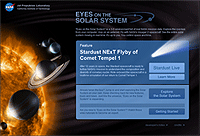
http://solarsystem.nasa.gov/eyes/
Psst! I think someone very close to the Forum had something to do with it. Shhhh. ![]()
Posted by: djellison Feb 14 2011, 06:13 AM
I've heard that someone might be demoing it live, twice, on the first NASA TV broadcast tomorrow evening, and that there might be a frickin great big camera on top of his console staring him in the face. ![]()
(and if I do say so myself, the C/A looks really awesome in EotSS - took some work by a very very clever programmer called Jon to get the camera to flip from periscope to off periscope. He's actually programmed the spacecraft to do faux-auto-nav based on the provided trajecgories for Stardust and Tempel 1. Plus - our 3D guy, haivng produced a BEAUTIFUL Stardust spacecraft, went and created a brailliant Tempel 1 complete with stuff seen by Deep Impact ( grey ) stuff not seen ( blue ) and the hoped-for crater ( red target )
If I do say so myself, it's fairly cool.
Oh and don't - whatever you do - look at the tutorials page.
Posted by: ElkGroveDan Feb 14 2011, 06:43 AM
Don't have any chocolate the night before. Never fails the day you are going to be on television ...
Posted by: MahFL Feb 14 2011, 12:10 PM
What time does the NASA tv coverage start ?
Posted by: Astro0 Feb 14 2011, 12:18 PM
Of course "what time?" depends on where you live on our worldwide forum.
The schedule is always available on the NASA http://www.nasa.gov/multimedia/nasatv/MM_NTV_Breaking.html...or just a Google query away.
Posted by: MahFL Feb 14 2011, 12:27 PM
I know, just being lazy, also I don't actually frequent the nasa site much, and would have had to guess where the tv schedule was......
Bottom line is it's on too late for me....I need to be zzzzzzzzz at 11:30 EST. Oh well.
Posted by: stevesliva Feb 14 2011, 05:52 PM
I don't know if these updates all came in at once, or if changes in the page format fooled feedity:
http://stardustnext.jpl.nasa.gov/mission/mission_status11_q1.html
Some excerpts.
The opnavs received today are all at 0.25 pixel quality, and have moved the solution since yesterday’s opnav solution. The science team believes that we are seeing the nucleus signal starting to come through, and these latest opnavs are the best indication of the nucleus location. The maneuver design is being finalized, and will be around a 170 km maneuver.
The overnight activities taken by the flight team went very well, and the final OpNavs taken at E-42 hours were successfully acquired and downlinked.
The navigation solutions were finished this morning, and they show that the predicted delivery is within the ‘green zone’ of the delivery chart. The nominal flyby point is at 191 km from the surface of the comet with a 11km uncertainty radius. The current Time of Closest Approach estimate is still around 04:40 UTC on February 15 (20:40 February 14 in Pasadena). Based on these discussions and updates, the following decisions were made, with full concurrence between the PM and PI:
- No TCM 34 will be executed
The spacecraft team has just completed the final commanding prior to encounter.
This included the encounter sequence and the supporting files that were built this afternoon with the final trajectory and time of arrival estimates.
Most fault protection has now been disabled, and the Mission Phase Bit has been set to ‘Encounter’. From now on, a safe mode entry will trigger the autorecovery sequence that will attempt to recover the spacecraft autonomously and restart the encounter sequence
Crazy! But after the worry, optical navigation got them where they wanted, with a TCM to spare.
Posted by: CosmicRocker Feb 14 2011, 06:37 PM
It's awesome. I'm going along for the ride!
Posted by: stevesliva Feb 14 2011, 09:02 PM
So there was just a large solar flare. Did that send high-energy particles towards Stardust, and if it did, when do they get there?
Posted by: brellis Feb 14 2011, 09:57 PM
I have EoSS on and Norton telemetry says it's safe! ![]()
Posted by: djellison Feb 14 2011, 10:12 PM
You'll want to re-start EotSS later ( about 8.30pm Pacific - just when the broadcast starts ) - as we'll have adjusted for the updated C/A time.
And that flare was on the Earth side of the sun ...and using EotSS (sorry to plug it so much ![]() ) you can see Stardust is on the other side of the Solar System.
) you can see Stardust is on the other side of the Solar System.
Posted by: ElkGroveDan Feb 14 2011, 11:56 PM
I used EotSS this weekend to wash my car and it did a marvelous job. It also repaired my grandfather's broken watch. I only wish I had discovered this incredible tool sooner. It really has changed my life.
Posted by: JohnVV Feb 15 2011, 12:41 AM
my only gripe it
the site is MS only
i could boot up an illegal copy of MS win7
For i have NO intention to buy it
Posted by: Ron Hobbs Feb 15 2011, 12:54 AM
When I try to go to the site, all I get is hash (bars of colors). ???
Posted by: djellison Feb 15 2011, 01:31 AM
That sometimes happens before your GFX card has finished initializing - give it time. If it doesn't clear after a few seconds, then...er.....it's still a beta.
NTV will be cutting to Eyes... live during the flyby
Posted by: nprev Feb 15 2011, 01:55 AM
EoTSS running sweet here on Win7...nice view!
Steady as she goes, Mr. Ellison! ![]()
Posted by: ElkGroveDan Feb 15 2011, 03:57 AM
While we are waiting for our Glorious Leader to take the stage, may I take this opportunity to remark how unbearably boring NASA TV is 99% of the time - especially immediately preceding live events.
EDIT - it's on now 8:20 pm PST
Posted by: MahFL Feb 15 2011, 04:32 AM
Watching.
Posted by: Explorer1 Feb 15 2011, 04:33 AM
Broadcast started now on NASAtv.
Posted by: ZLD Feb 15 2011, 04:35 AM
Its not PBS or the BBC, but it also receives a really small budget in comparison, and still is able to put on informative shows, albeit with a certain cheese factor.
Posted by: Explorer1 Feb 15 2011, 04:38 AM
Dust Flux instrument is on!
Posted by: CosmicRocker Feb 15 2011, 04:43 AM
EotSS demo coming up soon! ![]()
Posted by: Explorer1 Feb 15 2011, 04:45 AM
There's Doug!
Posted by: nprev Feb 15 2011, 04:48 AM
Well done, Doug!
Posted by: Explorer1 Feb 15 2011, 04:59 AM
Closest approach done! (my heart jumped when that guy said 'impact').
Posted by: ZLD Feb 15 2011, 05:01 AM
This is really a fantastic tool. Curious, is the positioning of the comet accurate? The last I was aware, the comet movement wasn't known well enough to predict it at that time.
Posted by: ElkGroveDan Feb 15 2011, 05:05 AM
The orbit of the comet is actually very well understood. The big unknown is its rotation, though they have a pretty good idea based on light curves.
Posted by: Explorer1 Feb 15 2011, 05:10 AM
More dust after CA than before; interesting.
Posted by: Hungry4info Feb 15 2011, 05:15 AM
Not at all surprising, imho. Outbound, the spacecraft is heading into the "tail" IIRC.
Edit: 181 km was closest approach.
Posted by: Astro0 Feb 15 2011, 05:29 AM
Doug was pretty awesome.
This was his view http://twitpic.com/3zywnw
Posted by: volcanopele Feb 15 2011, 05:44 AM
Well, clearly they are trying to center the comet in the frame so they will point to where they think the comet will be to the best of their knowledge of the predicted trajectory of both the comet and the spacecraft. Though obviously, when the real images, that doesn't mean the comet will actually be in the center of the image.
Posted by: belleraphon1 Feb 15 2011, 05:45 AM
Nicely done Doug!
Fun to watch simulation on 'Eyes on the Solar System'.
Comet encounters so exciting... dust impacts galore.... can't wait for images.
Have to nap for a few hours.... get up at 3:00am Eastern to see the fave five images and then out the door for work at 5:30am...
NASA TV boring!? At least we have coverage! I applaud them.
Craig
Posted by: Explorer1 Feb 15 2011, 05:48 AM
3 Ice Tea bottles of fuel, haha! I was wondering how much they'd have left.
Another layman's unit of measure!
EDIT: Prop on someone's desk too!
Posted by: CosmicRocker Feb 15 2011, 06:11 AM
Yeah, demo II was terrific. Now, I know how to drive this thing. ![]() I might even have to watch some of those demos on the home page.
I might even have to watch some of those demos on the home page.
Posted by: Astro0 Feb 15 2011, 06:17 AM
Canberra DSN did a great job today. Two antennas on point for the encounter and a very tired but happy team ![]()
Here's a pic of DSS43 in action from just a few minutes ago. http://twitpic.com/400llt
Posted by: dilo Feb 15 2011, 06:28 AM
Stardust seems very low on the horizon, indeed!
Posted by: Astro0 Feb 15 2011, 06:33 AM
Yep, we've been tracking all day, so a full horizon to horizon arc.
We'll be handing over to the Madrid DSN shortly.
Posted by: elakdawalla Feb 15 2011, 07:07 AM
Astro0, we don't say it enough: many many thanks to everyone at the DSN for making sure of the safe arrival of our precious data on Earth!
Posted by: ZLD Feb 15 2011, 07:51 AM
In relation to my question, I wasn't curious if the comet would be centered or if we knew the orbit, I was curious how well the orientation of the comet would appear in actuality versus what was seen in the simulation (was it set up to look the same/similar as what will be seen in the images).
Posted by: brellis Feb 15 2011, 07:59 AM
Mr. Ellison, that was a great presentation!
Posted by: djellison Feb 15 2011, 08:02 AM
We have a predicted trajectory for both spacecraft and comet - and then just like the spacecraft itself, Jon (lead dev for EotSS) programmed autonav - the spacecraft rotated and the mirror tracked to keep the comet in the middle of the field of view.
And as for geometry/lighting etc - we did our best to match this : http://2.bp.blogspot.com/-GgFZHEkOXh4/TVk-cZ4hVBI/AAAAAAAAAZA/nBC2TBoK1F8/s400/planned_1.jpg : and I think we did quite well. There's an adjustment we've made here to the timing (15 seconds early) - so the 5 images will be more like -21sec to +51sec rather than centered on C/A
And thanks for the kudos guys - a lot of fun tonight, and it seems like the technology for EotSS, and our faithful old spacecraft...has held up.
We're in for a slightly longer wait for the images, but hopefully it'll be worth it.
Posted by: djellison Feb 15 2011, 08:08 AM
the site is MS only
It's not. It's Mac or PC. I'm sorry it doesn't work for Linux, but that's just a symptom of the Unity plugin not being available for Linux. For 0.3% of the audience, I can understand their reluctance to develop one.
Posted by: Sunspot Feb 15 2011, 08:52 AM
Whats going on? lots of people around monitors.....my sound has gone off on the NASA feed
Posted by: Gsnorgathon Feb 15 2011, 09:15 AM
http://www.jpl.nasa.gov/news/stardust/ Tiny ones, so far. ~2,500km away.
Posted by: Explorer1 Feb 15 2011, 09:19 AM
First taken, rather then 'planned five'.
Unknown why this happened.
Posted by: Hungry4info Feb 15 2011, 09:19 AM
Apparently, they intended to download the closest approach images first, but for some unknown reason, the images are coming in in the order they were taken.
edit: Will have press conference tomorrow to show closest approach images.
edit2: Tomorrow being... in the morning
Posted by: Gsnorgathon Feb 15 2011, 09:22 AM
They're saying ~6hr wait to get the closest approach images. Looks like it's time for bed. (And great consolation for all the folks who couldn't stay up!)
Posted by: Explorer1 Feb 15 2011, 09:23 AM
2 up at : http://www.jpl.nasa.gov/news/stardust/
Flicking between them shows some vagueness...
Still to early to say for sure.
EDIT: several more: oh this is excruciating! Looks like some vague circle. Dare I say it's the crater? Going to be no matter what now. Press conference delayed so at least I'll get some sleep.
http://www.nasa.gov/images/content/516881main_n30008te01.jpg
Posted by: ugordan Feb 15 2011, 09:44 AM
This one is sharper - no motion blur: http://www.jpl.nasa.gov/news/stardust/index.php?fileID=6073
Posted by: Astro0 Feb 15 2011, 09:55 AM
EDIT: Revised animation sequence - first 6 images @200% (no sharpening)
Posted by: ugordan Feb 15 2011, 10:01 AM
6th image is down. Also blurry.
Tick... tock...
Posted by: jasedm Feb 15 2011, 10:02 AM
Hmmm tantalising, but still too early to say whether the same hemisphere's in view..
Posted by: Toma B Feb 15 2011, 10:20 AM
In image "n30007te01" 2 circular formations (craters) can be seen.
Could they be theese 2 craters?
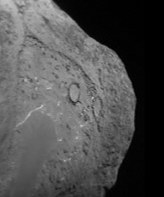
Posted by: ugordan Feb 15 2011, 10:24 AM
I don't know, the sharpened images Astro0 posted really suggest to me we're seeing that crater and crescent feature near the impact site, it's just that the comet is rotated slightly. If only my Photoshop at work didn't crap out on me...
If that is the case, it's also pretty obvious any resulting crater isn't huge.
Posted by: Sunspot Feb 15 2011, 11:36 AM
hmmm website stopped updating with images.
Posted by: MahFL Feb 15 2011, 12:17 PM
They are proberbly asleep, or keeping them back for the news conference. It's 4:16 am at JPL.
Also the spacecraft isn't sending the pictures down in the order expected.
Posted by: PaulM Feb 15 2011, 01:01 PM
The broad end of the nucleus seems to be facing Stardust in the photos. I think that this means that the plan to take a detailed photo the Deep Impact crater just before closest approach has succeeded.
On the TV coverage I saw someone pick up the comet model and point to the fat end of the nucleus. The bearded project scientist responsible for determining the rotation of the comet then vigourously nodded his head in agreement. This is encouraging. ![]()
Posted by: dilo Feb 15 2011, 01:51 PM
I tried to make crossed-eye stereogram with second and last pictures (after rotation/rescaling/sharpening processings):
Posted by: Hungry4info Feb 15 2011, 02:17 PM
http://www.cosmicdiary.org/blogs/nasa/franck_marchis/?p=1004
Posted by: ugordan Feb 15 2011, 02:24 PM
Do we know if the rotational phase seen by Stardust matched any seen by Deep Impact's HRI instrument during approach? Since the latter is a much higher res instrument, it actually picked up a good bit of rotation on the way in, as can be seen http://www.flickr.com/photos/ugordan/4244845380/.
For fun I tried matching one of the earlier HRI frames to the first good Stardust image. Looks like a slightly earlier snapshot than I picked would make a better fit, bit it was at too low a resolution. HRI image magnified some 200 % and rotated to "fit". Some vaguely similar albedo patterns there.
Posted by: Phil Stooke Feb 15 2011, 02:42 PM
My impression based on your animation is that the HRI image should be rotated 90 degrees clockwise to match the new view.
Phil
Posted by: ugordan Feb 15 2011, 02:46 PM
I rotated it slightly over 70 degrees clockwise. Close but no cigar?
Posted by: Phil Stooke Feb 15 2011, 03:15 PM
No, I mean the comparison as you presented it just above, still needs a 90 clockwise rotation. The bright spot on the right of your HRI image is the bottom point of the Stardust image. If you watch your animation zoomed in, you can see how the motion carries that bright spot down to the bottom of the nucleus, while the area that will become the one you're trying to match rotates into view.
Phil
Posted by: Hungry4info Feb 15 2011, 04:38 PM
Multiple new images, much closer to the comet.
http://www.jpl.nasa.gov/images/stardust/stardust2/n30029te01.jpg
http://www.jpl.nasa.gov/images/stardust/stardust2/n30031te01.jpg
http://www.jpl.nasa.gov/images/stardust/stardust2/n30032te01.jpg
Posted by: djellison Feb 15 2011, 04:41 PM
They're beautiful - utterly beautiful - I wasn't expecting the camera to perform quite so well.
Posted by: paxdan Feb 15 2011, 04:43 PM
crater identification in 3, 2, 1....
Posted by: Stu Feb 15 2011, 04:43 PM
Just catching up with this 'cos I've been at work all day until now, but wow, what an achievement. And well done Doug for all your hard work on this, too.
Amazing times we live in. Amazing times...
Posted by: Hungry4info Feb 15 2011, 04:44 PM
My best guess for the impact site (based on looking at the Deep Impact images).
Posted by: ZLD Feb 15 2011, 04:46 PM
Wow! I had honestly been expecting images much less clear than these. Looks like this mission will pay off nicely.
Posted by: Hungry4info Feb 15 2011, 04:47 PM
I'm impressed at the image quality too.
A couple closer images.
http://www.jpl.nasa.gov/images/stardust/stardust2/n30033te01.jpg
http://www.jpl.nasa.gov/images/stardust/stardust2/n30034te01.jpg
Posted by: tedstryk Feb 15 2011, 04:48 PM
My best guess for the impact site (based on looking at the Deep Impact images).
That crater is in the DI approach images, so it can't be it.
Posted by: Hungry4info Feb 15 2011, 04:51 PM
You're right, I got my orientation of the surface features wrong. It should be somewhere to the left of the circular crater.
Posted by: Phil Stooke Feb 15 2011, 04:56 PM
A bit of processing... some new territory - now if we can just look round the corner!
Phil
Posted by: ugordan Feb 15 2011, 04:58 PM
I'm also very pleasantly surprised by the images. Some of the early ones had what appears to be motion blur (dust impacts?) and varying exposure, but this is awesome quality! Kudos to the whole team.
Posted by: toddbronco2 Feb 15 2011, 05:02 PM
I think the identification of the DI crater from Hungry4Info was correct
It's the small white spot below the large crater, right?
Posted by: Hungry4info Feb 15 2011, 05:07 PM
My identification was incorrect. The crater will be somewhere inbetween the two neatly defined circular ones.
Posted by: Phil Stooke Feb 15 2011, 05:08 PM
According to the NASA site (as of right now), that last pic was taken from a distance of 946.05 trillion kilometers. That's quite a zoom lens they've got there.
(what's a factor of 10^12 between friends?)
Phil
Posted by: toddbronco2 Feb 15 2011, 05:12 PM
Rotated the Deep Impact image to be close to the Stardust orientation. I think...
Posted by: Bjorn Jonsson Feb 15 2011, 05:12 PM
WOW!! These images are far, far better than I was expecting.
Based on the DI 'first flash' image I think the crater might be approximately where the red arrow points but I'm not sure - and I can't identify anything that is obviously a new crater [EDIT: Probably a bit more to the right]:
Posted by: john_s Feb 15 2011, 05:19 PM
Stardust on the left, Deep Impact on the right, with the "official" impact site arrowed. I sure don't see the new crater...
John
Posted by: Hungry4info Feb 15 2011, 05:19 PM
I think I can see KrisK's and Bjorn's impact candidates in the pre-impact Deep Impact image.
Posted by: Phil Stooke Feb 15 2011, 05:21 PM
I've done a 'blink comparator' overlay job and I can't see anything that looks like a new feature. Some things seem to have disappeared, but nothing formed. Is it all either eroded away or buried under ejecta?
Phil
Posted by: Hungry4info Feb 15 2011, 05:22 PM
With a porous surface, and a dense impactor, I wouldn't be surprised if the comet more or less swalled the impactor without much of a crater.
Posted by: toddbronco2 Feb 15 2011, 05:22 PM
So the original impact plume from Deep Impact was too big and bright to see surface detail and yet the crater left behind is perhaps too small to even resolve? That's an interesting result!
Posted by: Phil Stooke Feb 15 2011, 05:22 PM
The instant science is just a-poppin' here! One thing's for sure, we're all guaranteed tenure.
Phil
Posted by: Bjorn Jonsson Feb 15 2011, 05:28 PM
Actually I was just trying to guess from the DI image approximately where the crater might be without actually trying to identify it in the new images so this is normal. One thing now seems certain though: Any crater from the DI impact isn't big (actually it occurs to me if there might possibly be no identifiable new crater, possibly due to a lot of dust?).
Posted by: Hungry4info Feb 15 2011, 05:30 PM
Phil mentions he's seen things have dissapeared. The crater may have eroded away over the past few years.
Posted by: Sunspot Feb 15 2011, 05:36 PM
But why wouldn't other craters/features seen in the Deep Impact images have eroded also?
weird
Posted by: toddbronco2 Feb 15 2011, 05:37 PM
Regardless of how visible the DI crater is, I'm very impressed with how well the predicted flyby geometry matches the images. It looks like they timed the flyby flawlessly. Despite the pre-flyby handwringing that they might have targeted the incorrect peak in the rotation light curve, it looks like they chose correctly!
Posted by: ugordan Feb 15 2011, 05:39 PM
Disappeared or invisible due to low phase angle?
Posted by: S_Walker Feb 15 2011, 05:44 PM
Fascinating images- much better than expected. Here's a processed version of the closest shot available at the moment.
Posted by: fredk Feb 15 2011, 05:44 PM
I'm wondering about the phase angle too. I was ready to declare an identification of the crater based on Phil's enhancement of this earlier image (see dark circularish ring inside my white circle):
But that dark ring seems to be invisible in the closer image. Could that be due to the change in viewing geometry?
Posted by: Hungry4info Feb 15 2011, 05:50 PM
More pics.
http://www.jpl.nasa.gov/images/stardust/stardust2/n30035te01.jpg
http://www.jpl.nasa.gov/images/stardust/stardust2/n30036te01.jpg
http://www.jpl.nasa.gov/images/stardust/stardust2/n30037te01.jpg
http://www.jpl.nasa.gov/images/stardust/stardust2/n30039te01.jpg
http://www.jpl.nasa.gov/images/stardust/stardust2/n30040te01.jpg
http://www.jpl.nasa.gov/images/stardust/stardust2/n30041te01.jpg
http://www.jpl.nasa.gov/images/stardust/stardust2/n30042te01.jpg
Posted by: djellison Feb 15 2011, 05:55 PM
Think of a sand dune.
Put a foot-print in it.
Following day...sand dune's still there...but the foot print isn't.
Posted by: tedstryk Feb 15 2011, 05:56 PM
Is there a need to link to every image? They can all be easily seen here http://www.nasa.gov/mission_pages/stardust/multimedia/version1/index.html
Posted by: volcanopele Feb 15 2011, 06:09 PM
Yeah, no crater... but maybe it caused the obliteration of the dark spot just above the arrow point in the DI image?
Posted by: CAP-Team Feb 15 2011, 06:12 PM
Great images! I expected the crater to be much bigger! Now we can't even find it.. ![]()
Posted by: jasedm Feb 15 2011, 06:17 PM
Absolutely amazing pictures - I was expecting less quality than the DI pics, but these are comparable if not better.
I'm amazed that the crater isn't very obvious considering the material plume the impactor kicked out. That's 370kg's of copper travelling at around 10km/second.
Apparently a crater in the order of 100m in diameter was envisaged. The surface obviously absorbs an impactor much more than expected.
Simply amazing work on the part of the team to achieve this sort of targeting and imaging.
Posted by: ugordan Feb 15 2011, 06:20 PM
What pathetic humans we are, we can't even make a lasting impact on a measly comet...
Looking at Emily's http://www.planetary.org/blog/article/00002917/, it looks like I got the geometry in post http://www.unmannedspaceflight.com/index.php?s=&showtopic=6868&view=findpost&p=170660 about right after all.
Posted by: PaulM Feb 15 2011, 06:24 PM
The "EPOXI mission" scientists seem to be just as confused as the rest of us:
"Using the composite image from Deep Impact and cropping, rotating, brightening 30036 from SD-N...Where's the crater??."
http://www.facebook.com/permalink.php?story_fbid=151095161611151&id=1573578549#!/photo.php?fbid=499567526726&set=a.494441911726.269083.290094756726&theater
http://www.facebook.com/photo.php?fbid=499567526726&set=a.494441911726.269083.290094756726&theater#!/EPOXI
To see the link you need first to log on using FACEBOOK. I have proven that any account will do.
Posted by: stevesliva Feb 15 2011, 06:27 PM
Your processed image has the closest thing I can see to detail at the impact site. 'course I'm not sure it's real.
Posted by: Paolo Feb 15 2011, 06:30 PM
kudos to the science team! not only for the successful flyby, but also for getting the phase right!
and the "mystery of the missing crater" is amazing instant science. we are privileged to have seen this live!
Posted by: S_Walker Feb 15 2011, 06:42 PM
Thanks. My processing steps were to crop the image to 548x548 pixels, upsample 50%, deconvolve using Richardson-Lucy (10 iterations, PSF of 0.8 pixels), and very mild wavelet filter.
Posted by: S_Walker Feb 15 2011, 06:44 PM
the "closest approach" image (n30037te01), processed using the same steps as mentioned previously.
Posted by: Littlebit Feb 15 2011, 06:46 PM
Supercomet!
'shudda made the probe out of Kryptonite
Posted by: Byran Feb 15 2011, 07:00 PM
But that dark ring seems to be invisible in the closer image. Could that be due to the change in viewing geometry?
http://www.nasa.gov/images/content/516975main_n30036te01.jpg
?

Posted by: dilo Feb 15 2011, 07:03 PM
This is my (very tentative) guess:
On the left/center, Deep Impact distorted version before/during impact.
Posted by: Phil Stooke Feb 15 2011, 07:08 PM
Three views of the nucleus, oriented with south roughly at the bottom.
Phil
Posted by: jasedm Feb 15 2011, 07:12 PM
The joy of science - valuable results whether you see what you expected or not.
![]()
Posted by: jgoldader Feb 15 2011, 07:35 PM
It's the lack of even an obvious albedo feature that surprises me the most. The impact threw up so much material, I'd have guessed it would leave more of a trace, even if it didn't make a significant crater.
The only thing that comes to mind is that if the material in the top tens of meters is well-mixed, there'd be no reason for significant albedo features due to the impact, since everything you dig up looks like the material already on the surface. If the surface is fairly soft, then it could've just been unable to retain a crater. (As was already mentioned, a footprint in sand might disappear overnight.)
Jeff
Posted by: tasp Feb 15 2011, 07:44 PM
![]()
We probably would not be able to recognize a new crater antipodal to the entry wound . . .
Posted by: Explorer1 Feb 15 2011, 07:46 PM
Amazing stuff, it's funny how the camera got better results now than with Wild 2, when it was a bit newer.
No obvious crater should narrow down the contest significantly... I remember a theory pre-impact that the projectile would punch a whole clean through the comet! (EDIT: Tasp beat me to that!)
Fascinating views of the far side as well... a long, thin dark feature on both sides.
Posted by: machi Feb 15 2011, 07:55 PM
Byron:
We have same idea!
Quick and dirty attempt to find DI crater. Looks like big boulder from impactor images is gone.
Posted by: elakdawalla Feb 15 2011, 08:00 PM
We've all been so busy hunting for the crater, I haven't seen anyone looking to see whether that flat tongue of material has expanded or retracted since DI saw it!
Posted by: Paolo Feb 15 2011, 08:25 PM
I wanted to have a look at it, but the illumination doesn't help...
Posted by: Byran Feb 15 2011, 08:26 PM
We have same idea!
Quick and dirty attempt to find DI crater. Looks like big boulder from impactor images is gone.
This item is in the center of impactor's last shot.
http://deepimpact.umd.edu/gallery/ITS_PR4-PIA02129.html
Posted by: Explorer1 Feb 15 2011, 08:30 PM
Briefing at 12:45 now, apparently.
Posted by: jasedm Feb 15 2011, 08:49 PM
I wonder if these results will change informed opinion on the effectiveness of attempting to use a nuclear device to divert an earth-bound comet.
The DI impactor imparted energy equivalent to around 5 tonnes of TNT, but we can't even see the resultant damage, from close range and with a pretty decent camera.
Posted by: elakdawalla Feb 15 2011, 08:54 PM
So remember how there were supposed to be 5 images near closest approach that were queued first for transmission to Earth? Well....about that....it seems they somehow wound up being the LAST transmitted. That's the reason for the most recent delay to the press briefing. Ooops!
Unrelated topic: has anybody here worked with Halley Multicolor Camera images?
Posted by: Explorer1 Feb 15 2011, 08:56 PM
Starting now!
Posted by: machi Feb 15 2011, 09:10 PM
One year ago.
http://planets.wz.cz/icybody/icybody.htm
Posted by: Explorer1 Feb 15 2011, 09:11 PM
150 meter crater, with mound!
Posted by: Rick Sternbach Feb 15 2011, 10:00 PM
I haven't been able to tune in to NASA-TV, but did manage to fiddle with one of the new images in Photoshop. Just as a fun exercise, I want to see if I'm even close to seeing the spot. Just so folks know, THIS ISN'T AN OFFICIAL PHOTO. Just my fiddling. Looks like a dark spot with radial stuff and material draped over an edge.
Rick
Posted by: ngunn Feb 15 2011, 10:17 PM
Before and after comparison from the NASA website: http://www.nasa.gov/mission_pages/stardust/multimedia/Schultz4.html
It seems to have demolished a small peak.
Posted by: Explorer1 Feb 15 2011, 10:17 PM
That's what I figured it was too, Rick. Far more subtle then the natural craters.
Posted by: ugordan Feb 15 2011, 10:26 PM
Nice, thanks. I can see topography, but nothing that would suggest any crater rim and central mound where it's supposed to be. Oh well.
Posted by: Rick Sternbach Feb 15 2011, 10:29 PM
I just saw the image of the crater they showed at the press conference. By George, I think I got it. ![]() - Rick
- Rick
Posted by: stevesliva Feb 15 2011, 10:36 PM
Yeah. Looks to me like the area in question has changed quite substantially, but I cannot say what it's changed into. Looks more like a tiny crater with a raised rim to me, but it's hardly clear.
Posted by: machi Feb 15 2011, 10:43 PM
Another crosseye view, now only crater area and from different images.
Posted by: Hungry4info Feb 15 2011, 11:13 PM
What's interesting to me is that the crater left by the impactor didn't seem to drastically disturb the crater just "below" it. If you didn't know it was left five years ago, you might be forgiven for thinking it were older than the natural craters. That, to me, suggests a lot of the energy of the impact was dissipated into the comet instead of out to the sides as you would expect for a surface with a higher density, less porous composition, etc. It's almost like the impactor sunk in. I wonder how much of it is left down under there.
Posted by: fredk Feb 16 2011, 01:36 AM
I'm still somewhat sceptical about the official crater ID, even if it agrees with my own original ID! Looking at this flicker gif, it seems to me that the "central peak" may be a pre-existing feature:
Anyway, there seem to be other substantial changes in between the visits - eg, the most prominent fracture/cliff running towards the lower left from the upper of the two largest craters in that view seems to change from the 8 o'clock to the 7 o'clock position relative to the upper crater.
My attempt here was quick and dirty. It'd be very cool if someone could do some non-trivial transformation to better line up the two views. Can someone ID several control points and distort one image to match the other?
Posted by: eoincampbell Feb 16 2011, 03:42 AM
Thanks to all wizards at Stardust Team, JPL and UMSF for a thrilling scientific adventure...(and great thread!) ![]()
Posted by: stevesliva Feb 16 2011, 06:04 AM
Penultimate status update:
All encounter data was downlinked and verified uncorrupted in the SDC (Science Data Center). PI and DPI gave go to erase images and begin departure imaging.
The spacecraft has been reconfigured for post-encounter, FP has been re-enabled, and the heap has been reallocated, enabling new images to be acquired.
The departure imaging will start tonight and will continue until PI determines no further useful science is being collected.
Thank you all for your help and support.
Next report – after decommissioning activities.
Posted by: CosmicRocker Feb 16 2011, 08:21 AM
Good job, Fred!
Posted by: Ian R Feb 16 2011, 09:02 AM
Here's my hastily assembled movie of the encounter (containing 61 frames):
http://www.youtube.com/watch?v=CFkeDmMVwWA
Posted by: brellis Feb 16 2011, 09:26 AM
dang, looked like we were going to hit the thing! ![]()
thanks Ian, that helps put the time frame of the encounter in perspective ![]()
Posted by: Ian R Feb 16 2011, 09:47 AM
You're welcome! Only problem is, the movie is playing in reverse! I've updated the link in my previous post for the slightly slower, 'forward' version. ![]()
Posted by: MahFL Feb 16 2011, 11:15 AM
Remember, nothing, except maybe matter itself, is perminent in the Universe, even stars are born and they also die.
Posted by: Drkskywxlt Feb 16 2011, 01:50 PM
How much of that is viewing geometry? Certainly seems like the two images there have a different phase angle to the target...hard to confidently see true changes, IMHO.
Posted by: machi Feb 16 2011, 02:16 PM
I think, that almost all subtle differences are caused by different viewing geometry. This is reason, why I mark only two prominent change (new crater and regress of smooth material, which looks as real change).
Posted by: fredk Feb 16 2011, 03:19 PM
Thanks a lot for that, Machi - that's exactly what I had in mind. I'm curious what software you used to distort the DI image?
Posted by: machi Feb 16 2011, 03:33 PM
http://rsb.info.nih.gov/ij/ + http://biocomp.cnb.uam.es/~iarganda/bUnwarpJ/ plugin.
Posted by: Phil Stooke Feb 16 2011, 04:20 PM
Aha! I've been looking for a new rubber-sheeting program for ages. I'm using a geocorrection routine in a GIS. This looks promising as an alternative. Thanks!
Phil
Posted by: Phil Stooke Feb 16 2011, 06:26 PM
Yes - good observation! They look good when enhanced - like Enceladus!
Phil
Posted by: Ian R Feb 16 2011, 07:46 PM
My attempt at stacking images to make the crater (and mound) more visible:
Posted by: ZLD Feb 16 2011, 08:47 PM
Good find!
This is as good as I could do resolving them without too much noise.
Posted by: Oersted Feb 16 2011, 10:52 PM
That one worked for me, I can see the new crater, excellent, thank you!
Posted by: Phil Stooke Feb 17 2011, 02:32 PM
More on the jets... here I have made the image into a cylindrical projection. The limb would be a horizontal line if the nucleus was spherical. The jets show up nicely. The three long arrows are the three Emily first noted. Two short arrows identify two more. There are signs of small jets between the first three, and a diffuse zone of emission to the right of the other jets. A feature at the left end might be dark-side topography illuminated by light reflected off a nearby sunlit ridge.
Phil
Posted by: vossinakis Feb 17 2011, 03:12 PM
Nice find. Whats the address of the original image?
Posted by: ZLD Feb 17 2011, 03:54 PM
Interesting method Phil. The results of the projection are very nice. What plugin / software did you use to produce that?
Posted by: Phil Stooke Feb 17 2011, 04:35 PM
My image was made by using filter - distort - polar coordinates (polar to rectangular) in Photoshop, after moving the (approximate) center of the disk to the middle of the image. The black parabolas are places where I added space round the original image (image - canvas size) to create space to allow me to center the image.
Phil
Posted by: elakdawalla Feb 17 2011, 05:01 PM
Ha, I'm usually the one asking that, sorry! It's on Photojournal now:
http://photojournal.jpl.nasa.gov/catalog/PIA13860
Posted by: Juramike Feb 17 2011, 05:32 PM
Wha??? I don't see the latest images in the Comets and Small Bodies gallery of the Planetary Photojournal
Did pull them up using search option for Stardust spacecraft:
http://photojournal.jpl.nasa.gov/spacecraft/Stardust
Posted by: elakdawalla Feb 17 2011, 05:35 PM
The link I most commonly use at Photojournal is: http://photojournal.jpl.nasa.gov/new (which you can also get to by clicking on "latest images" at the bottom of the homepage)
Posted by: dilo Feb 17 2011, 09:15 PM
My version of enhanced jets, starting from TIFF image and using solarization+gamma+sharpening...
For sure, jets and halo aren't artifact because you can see also the nucleus shadow projected on the gas in the upper part.
Thanks to Emily for thie amazing highlight!!!
Posted by: machi Feb 17 2011, 11:17 PM
I see eight jets and another one in Phil's reprojected image (9!). I look forward to raw images ![]() .
.
Finally I finished morphed animation from twelve images - http://www.youtube.com/watch?v=Fy90BWvqzjY.
Posted by: stevesliva Feb 17 2011, 11:31 PM
Fantastic, as usual. And also perhaps the coolest illustration of apparent hue changing with phase angle that I've seen. Just as I was wondering why one side was browner than the other, the colors flipped.
Posted by: elakdawalla Feb 17 2011, 11:33 PM
There isn't any color data; what you're seeing are phase angle effects coupled with the autostretch on the images. I think that machi just colored the whole thing a sort of brown shade that matches the overall color from Deep Impact's color imaging.
(Awesome animation!)
Posted by: ZLD Feb 17 2011, 11:35 PM
Fantastic as always machi!
Posted by: ElkGroveDan Feb 17 2011, 11:42 PM
Beautiful!
Posted by: machi Feb 18 2011, 12:12 AM
Thanks!
Emily is all right. Color is from Deep Impact's images and it's applied as global color. Phase angle effects are apparent, but they are interfered by evident autostretch in original images.
Posted by: eoincampbell Feb 18 2011, 01:23 AM
Always a joy to watch your morphs, Machi, gorgeous, ghostly beauty...
Posted by: Juramike Feb 18 2011, 05:07 AM
Animated sequence from just before C/A to about 2500 km out. Individual images have been rotated and registered to minimize rotation:
[Animated GIF: click to animate]
Full-res here: http://www.flickr.com/photos/31678681@N07/5454806379/
(I needed to register the images for an outreach talk at a local museum: I'm working on a shorter animated GIF of the departure sequence.)
Posted by: brellis Feb 18 2011, 08:19 AM
You must be a Knight of the Tempel
Simply wonderful, machi -- thanks for sharing!
Posted by: nprev Feb 18 2011, 08:39 AM
Absolute. Freaking. Wizardry. ![]()
That's really, really impressive, Daniel.
Posted by: tedstryk Feb 18 2011, 12:34 PM
Yes, amazing!
Posted by: hendric Feb 18 2011, 03:47 PM
Vossinakis,
Could you do an animation of the flyby that way? That would be neat, and give us sort of an idea where the jets are originating.
Posted by: djellison Feb 18 2011, 04:24 PM
The jets are only visible on a couple of images - not all of them. The exposures were set longer on a few certain images to try and catch them.
Posted by: Juramike Feb 20 2011, 02:16 AM
The full animation sequence is now up on Planetary Photojournal: http://photojournal.jpl.nasa.gov/catalog/PIA13867
I've finished the two animated sequence I was going after, they are on my flickr page if anyone is interested:
http://www.flickr.com/photos/31678681@N07/5459663885/
http://www.flickr.com/photos/31678681@N07/5460272332/
Posted by: MizarKey Feb 21 2011, 12:20 AM
Full-res here: http://www.flickr.com/photos/31678681@N07/5454806379/
(I needed to register the images for an outreach talk at a local museum: I'm working on a shorter animated GIF of the departure sequence.)
Wow, that's sweet. Reminds me of the encounter with Mathilde. Thanks for the animation.
Posted by: machi Feb 21 2011, 11:54 AM
I've finished the two animated sequence I was going after, they are on my flickr page if anyone is interested:
http://www.flickr.com/photos/31678681@N07/5459663885/
http://www.flickr.com/photos/31678681@N07/5460272332/
I think, that your, Emily's and Ian's versions are actually better than the official one.
Posted by: machi Feb 23 2011, 07:59 PM
I looked at best image of the comet Tempel 1 with jets and I tried some basic comparison with old Deep Impact's images.
Notable change is missing massive jet, which is visible on the left in Deep Impact images.
Another thing is, that Stardust's images are in fact better in terms of resolution of jets, because in better (with higher resolution) images from Deep Impact
jets were drowned out by Impactor's explosion.
Posted by: stevesliva Mar 16 2011, 09:15 PM
http://stardustnext.jpl.nasa.gov/mission/mission_status11_q1.html
Stardust: I'm not dead yet.
The spacecraft continues its post-encounter cruise. All subsystems continue to operate as expected. The team is preparing for the decommissioning maneuver, and the decommissioning plan has been prepared and reviewed. The primary date for the decommissioning activity is March 24, with a back-up opportunity on April 7. The Decommissioning Review has been scheduled for March 18 at JPL.
Decom "maneuver" makes me wonder if they're planning a burn to depletion to see what propellant they had left.
Posted by: toddbronco2 Mar 17 2011, 03:18 PM
I asked the Project Manager, Tim Larson, precisely that question back before the Tempel 1 flyby and he indicated that indeed, a burn to depletion is planned in the decommissioning. Such a maneuver provides a valuable opportunity to test the precision of several methods of modeling the remaining fuel onboard and that validation can benefit other JPL and NASA missions.
Posted by: djellison Mar 23 2011, 11:53 PM
Time to say goodbye.
http://www.jpl.nasa.gov/news/news.cfm?release=2011-094
Tomorrow night, PDT.
Posted by: tedstryk Mar 24 2011, 12:14 AM
Someone needs to update the blurb at the end.
Posted by: djellison Mar 24 2011, 01:24 AM
The boilerplate press blurb is on overtime as well I think ![]()
Posted by: Poolio Mar 24 2011, 12:18 PM
Looks like someone did. Future verb tense has been replaced with the infinitive.
Nice way to end a mission. It doesn't mention it in the article, but is the burn designed to send the craft in any particular direction, e.g., a long slow spiral into the sun? It mentions that the post-burn trajectory is somewhat unknown (contingent on the length of the burn), and the projection itself would seem to suggest that there is some interest in getting it out of our neighborhood.
Posted by: Phil Stooke Mar 24 2011, 12:53 PM
In orbital dynamics there's no such thing as a 'long slow spiral into the sun'. You make a change in velocity with the rocket burn, that defines a new orbit, and you stay in that orbit forever unless something else disturbs you (like a planetary flyby). The main concern here was that the orbit would not impact Mars or Earth. The small and unpredictable thrust most likely made only a small difference to the orbit anyway.
Phil
Posted by: Poolio Mar 24 2011, 02:46 PM
Thanks for straightening me out, Phil. I probably should have known this; I've read enough that I should understand by now how it works, but my Earth-bound mind insists on thinking in terms of friction and drag and loss of momentum.
Posted by: stevesliva Mar 24 2011, 04:42 PM
There was some new info on the status page... they actually decided to hurry things up a few days ago.
The spacecraft continues its post-encounter cruise. The decommissioning review was held on March 18, with the board recommending six actions to be addressed prior to the planned April 7 decommissioning activity. However, a 2 psi pressure drop was observed in the fuel tank over the weekend, leading the propulsion experts to believe that a gas bubble has made its way into the propellant management device, implying the tank might be getting to the end of the propellant. This prompted the team to reconsider the planned date for the decommissioning. With the consent of senior management and NASA HQ, the decommissioning burn will be executed on March 24. This will help the team determine how much fuel is actually left in the tank, providing data that will be valuable to other missions nearing the end of their fuel supply. After this activity, the spacecraft will be commanded into safe mode with the transmitter off. This will mark the end of a wonderful 12 year mission for the Stardust spacecraft. During that time it has flown by an asteroid and two comets, and returned samples of comet dust to earth for detailed study.
Posted by: nprev Mar 25 2011, 12:21 AM
If a controllable (key word) impact with Earth were feasible, I'd actually consider that a useful EOL maneuver. Not only would the spacecraft be decisively desposed of, but if done in a widely observable (but safe) way it would be a nice outreach opportunity...an artificial bolide.
Perhaps this will be practical for some future mission.
Posted by: monty python Mar 25 2011, 06:34 AM
Mission complete. The engine burned for 146 seconds.
Goodbye old friend.
Posted by: ugordan Nov 3 2011, 06:39 PM
Just a heads-up that the Tempel 1 flyby data is http://pdssbn.astro.umd.edu/holdings/sdu-c_cal-navcam-3-next-tempel1-v1.0/ at the PDS Small Bodies Node.
One takeaway image, before closest approach:
Posted by: machi Nov 3 2011, 07:27 PM
"oh my God—it's full of jets!" (as compared to older jpeg previews) ![]()
Cross-eye stereogram:
Posted by: machi Nov 3 2011, 09:12 PM
BTW, I just read on Twitter, that "Image data from Stardust's flyby of comet Tempel 1 has just been posted to NASA's public archive".
No, they are here already for 3 weeks (from 13.10.). ![]()
Posted by: Adam Hurcewicz Nov 6 2011, 10:14 AM
Hi, this link not work ;(
Posted by: elakdawalla Nov 6 2011, 09:26 PM
Turns out they hadn't meant for the data to be public yet; the data set is still under review. They didn't count on you guys noticing it was there. They underestimated you ![]()
Posted by: elakdawalla Feb 26 2012, 10:43 PM
http://pds-smallbodies.astro.umd.edu/data_sb/missions/stardustnext/index.shtml
Posted by: Paolo Feb 29 2012, 07:00 PM
anybody know if (and possibly when) results from the Tempel flyby are going to be published in Science?
Posted by: Explorer1 Aug 14 2014, 09:21 PM
Sorry for the bump, but possible interstellar dust (from the original mission)!
http://www.jpl.nasa.gov/news/news.php?release=2014-278
Interview with one of the Canadian citizen-scientists http://www.cbc.ca/news/technology/stardust-citizen-scientist-finds-first-dust-from-outside-solar-system-1.2736547?cmp=rss&utm_source=dlvr.it&utm_medium=twitter
Posted by: Antdoghalo Jun 14 2020, 06:57 AM
Sorry to resurrect a long dead thread but, this is a nice map I found in a document there showing the expanded coverage.
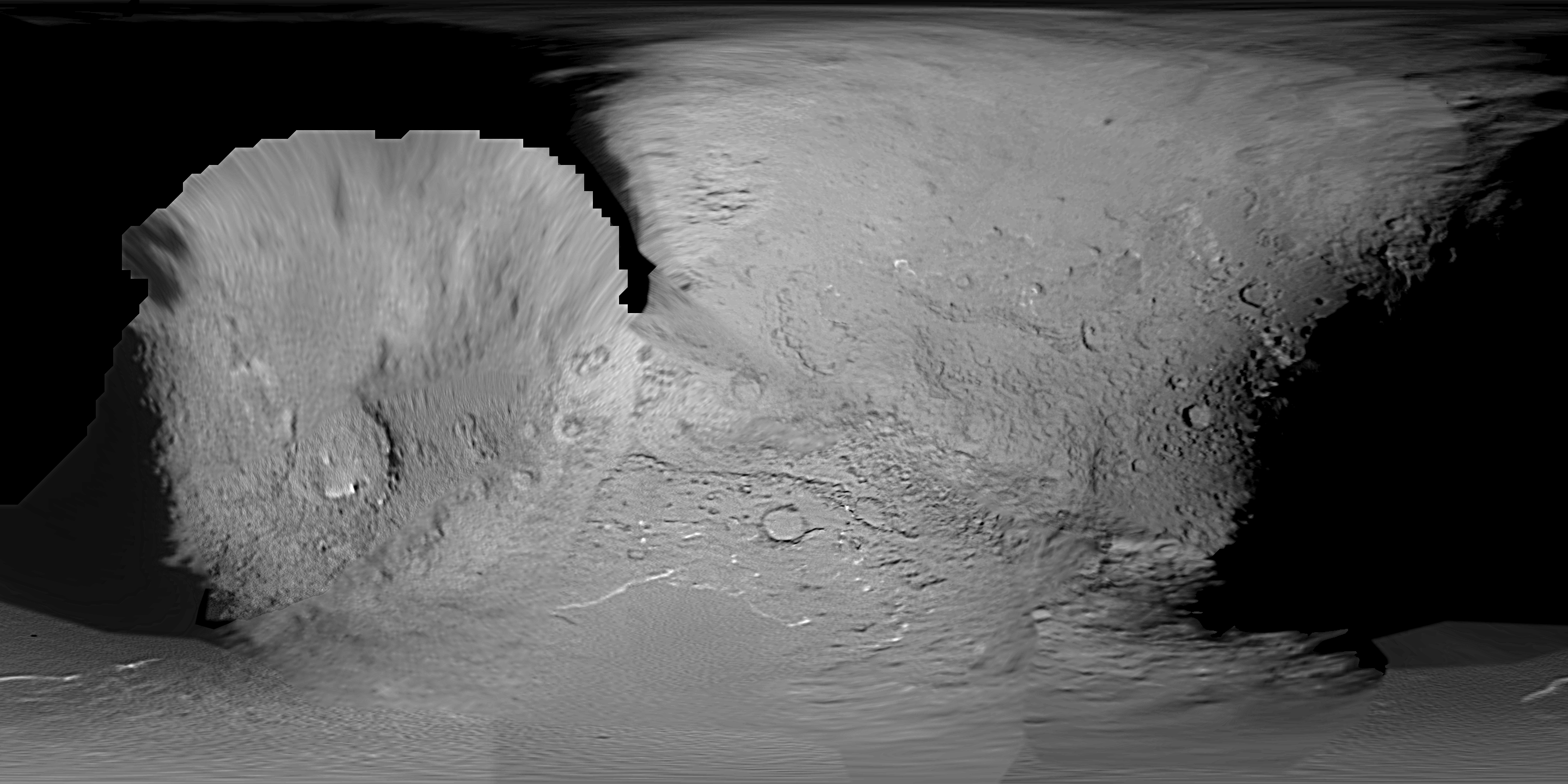
Powered by Invision Power Board (http://www.invisionboard.com)
© Invision Power Services (http://www.invisionpower.com)

